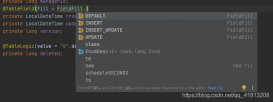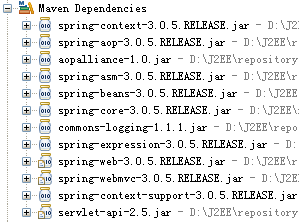@RestController和@RequestMapping注解
4.0重要的一个新的改进是@RestController注解,它继承自@Controller注解。4.0之前的版本,Spring MVC的组件都使用@Controller来标识当前类是一个控制器servlet。使用这个特性,我们可以开发REST服务的时候不需要使用@Controller而专门的@RestController。
当你实现一个RESTful web services的时候,response将一直通过response body发送。为了简化开发,Spring 4.0提供了一个专门版本的controller。下面我们来看看@RestController实现的定义:
|
1
2
3
4
5
6
7
8
9
10
11
12
|
@Target(value=TYPE) @Retention(value=RUNTIME) @Documented @Controller @ResponseBodypublic @interface RestController @Target(value=TYPE) @Retention(value=RUNTIME) @Documented @Controller @ResponseBodypublic @interface RestController |
@RequestMapping 注解提供路由信息。它告诉Spring任何来自"/"路径的HTTP请求都应该被映射到 home 方法。 @RestController 注解告诉Spring以字符串的形式渲染结果,并直接返回给调用者。
注: @RestController 和 @RequestMapping 注解是Spring MVC注解(它们不是Spring Boot的特定部分)
@EnableAutoConfiguration注解
第二个类级别的注解是 @EnableAutoConfiguration 。这个注解告诉Spring Boot根据添加的jar依赖猜测你想如何配置Spring。由于 spring-boot-starter-web 添加了Tomcat和Spring MVC,所以auto-configuration将假定你正在开发一个web应用并相应地对Spring进行设置。Starter POMs和Auto-Configuration:设计auto-configuration的目的是更好的使用"Starter POMs",但这两个概念没有直接的联系。你可以自由地挑选starter POMs以外的jar依赖,并且Spring Boot将仍旧尽最大努力去自动配置你的应用。
你可以通过将 @EnableAutoConfiguration 或 @SpringBootApplication 注解添加到一个 @Configuration 类上来选择自动配置。
注:你只需要添加一个 @EnableAutoConfiguration 注解。我们建议你将它添加到主 @Configuration 类上。
如果发现应用了你不想要的特定自动配置类,你可以使用 @EnableAutoConfiguration 注解的排除属性来禁用它们。
|
1
2
3
4
5
6
7
8
9
10
11
12
13
14
15
|
<pre name="code" class="java">import org.springframework.boot.autoconfigure.*; import org.springframework.boot.autoconfigure.jdbc.*; import org.springframework.context.annotation.*; @Configuration@EnableAutoConfiguration(exclude={DataSourceAutoConfiguration.class}) public class MyConfiguration { } <pre name="code" class="java">import org.springframework.boot.autoconfigure.*;import org.springframework.boot.autoconfigure.jdbc.*;import org.springframework.context.annotation.*;@Configuration@EnableAutoConfiguration(exclude={DataSourceAutoConfiguration.class})public class MyConfiguration {}@Configuration |
Spring Boot提倡基于Java的配置。尽管你可以使用一个XML源来调用 SpringApplication.run() ,我们通常建议你使用 @Configuration 类作为主要源。一般定义 main 方法的类也是主要 @Configuration 的一个很好候选。你不需要将所有的 @Configuration 放进一个单独的类。 @Import 注解可以用来导入其他配置类。另外,你也可以使用 @ComponentScan 注解自动收集所有的Spring组件,包括 @Configuration 类。
如果你绝对需要使用基于XML的配置,我们建议你仍旧从一个 @Configuration 类开始。你可以使用附加的 @ImportResource 注解加载XML配置文件。
@Configuration注解该类,等价 与XML中配置beans;用@Bean标注方法等价于XML中配置bean
|
1
2
3
|
@ComponentScan(basePackages = "com.hyxt",includeFilters = {@ComponentScan.Filter(Aspect.class)}) @ComponentScan(basePackages = "com.hyxt",includeFilters = {@ComponentScan.Filter(Aspect.class)})@SpringBootApplication |
很多Spring Boot开发者总是使用 @Configuration , @EnableAutoConfiguration 和 @ComponentScan 注解他们的main类。由于这些注解被如此频繁地一块使用(特别是你遵循以上最佳实践时),Spring Boot提供一个方便的 @SpringBootApplication 选择。
该 @SpringBootApplication 注解等价于以默认属性使用 @Configuration , @EnableAutoConfiguration 和 @ComponentScan 。
|
1
2
3
4
5
6
7
8
9
10
11
12
13
14
15
16
17
18
|
package com.example.myproject; import org.springframework.boot.SpringApplication; import org.springframework.boot.autoconfigure.SpringBootApplication; @SpringBootApplication // same as @Configuration @EnableAutoConfiguration @ComponentScan public class Application { public static void main(String[] args) { SpringApplication.run(Application.class, args); } } package com.example.myproject;import org.springframework.boot.SpringApplication;import org.springframework.boot.autoconfigure.SpringBootApplication;@SpringBootApplication // same as @Configuration @EnableAutoConfiguration @ComponentScanpublic class Application { public static void main(String[] args) { SpringApplication.run(Application.class, args); }} |
Spring Boot将尝试校验外部的配置,默认使用JSR-303(如果在classpath路径中)。你可以轻松的为你的@ConfigurationProperties类添加JSR-303 javax.validation约束注解:
|
1
2
3
4
5
6
7
8
9
10
11
12
13
14
15
16
17
18
19
20
21
22
23
24
25
26
27
|
@Component@ConfigurationProperties(prefix="connection") public class ConnectionSettings { @NotNullprivate InetAddress remoteAddress; // ... getters and setters } @Component@ConfigurationProperties(prefix="connection")public class ConnectionSettings {@NotNullprivate InetAddress remoteAddress;// ... getters and setters}@ProfilesSpring Profiles提供了一种隔离应用程序配置的方式,并让这些配置只能在特定的环境下生效。任何@Component或@Configuration都能被@Profile标记,从而限制加载它的时机。[java] view plain copy print?在CODE上查看代码片派生到我的代码片@Configuration@Profile("production") public class ProductionConfiguration { // ... } @Configuration@Profile("production")public class ProductionConfiguration {// ...}@ResponseBody |
表示该方法的返回结果直接写入HTTP response body中
一般在异步获取数据时使用,在使用@RequestMapping后,返回值通常解析为跳转路径,加上
@responsebody后返回结果不会被解析为跳转路径,而是直接写入HTTP response body中。比如
异步获取json数据,加上@responsebody后,会直接返回json数据。
@Component:
泛指组件,当组件不好归类的时候,我们可以使用这个注解进行标注。一般公共的方法我会用上这个注解
@AutoWired
byType方式。把配置好的Bean拿来用,完成属性、方法的组装,它可以对类成员变量、方法及构
造函数进行标注,完成自动装配的工作。
当加上(required=false)时,就算找不到bean也不报错。
@RequestParam:
用在方法的参数前面。
|
1
2
|
@RequestParam String a =request.getParameter("a")。 @RequestParam String a =request.getParameter("a")。 |
@PathVariable:
路径变量。
|
1
2
3
4
5
6
7
8
|
RequestMapping("user/get/mac/{macAddress}") public String getByMacAddress(@PathVariable String macAddress){ //do something; } RequestMapping("user/get/mac/{macAddress}")public String getByMacAddress(@PathVariable String macAddress){//do something;} |
参数与大括号里的名字一样要相同。
以上注解的示范
|
1
2
3
4
5
6
7
8
9
10
11
12
13
14
15
16
17
18
19
20
21
22
23
24
25
26
27
28
29
30
31
32
33
34
35
36
37
38
39
40
41
42
43
44
45
46
47
48
49
50
51
52
53
54
|
/** * 用户进行评论及对评论进行管理的 Controller 类; */@Controller@RequestMapping("/msgCenter") public class MyCommentController extends BaseController { @Autowired CommentService commentService; @Autowired OperatorService operatorService; /** * 添加活动评论; * * @param applyId 活动 ID; * @param content 评论内容; * @return */ @ResponseBody @RequestMapping("/addComment") public Map<String, Object> addComment(@RequestParam("applyId") Integer applyId, @RequestParam("content") String content) { .... return result; } } /** * 用户进行评论及对评论进行管理的 Controller 类; */@Controller@RequestMapping("/msgCenter")public class MyCommentController extends BaseController { @Autowired CommentService commentService; @Autowired OperatorService operatorService; /** * 添加活动评论; * * @param applyId 活动 ID; * @param content 评论内容; * @return */ @ResponseBody @RequestMapping("/addComment") public Map<String, Object> addComment(@RequestParam("applyId") Integer applyId, @RequestParam("content") String content) { .... return result; }}@RequestMapping("/list/{applyId}") public String list(@PathVariable Long applyId, HttpServletRequest request, ModelMap modelMap) { } @RequestMapping("/list/{applyId}") public String list(@PathVariable Long applyId, HttpServletRequest request, ModelMap modelMap) {} |
全局处理异常的:
@ControllerAdvice:
包含@Component。可以被扫描到。
统一处理异常。
@ExceptionHandler(Exception.class):
用在方法上面表示遇到这个异常就执行以下方法。
|
1
2
3
4
5
6
7
8
9
10
11
12
13
14
15
16
17
18
19
20
21
22
23
24
25
26
27
28
29
30
31
32
|
/** * 全局异常处理 */@ControllerAdviceclass GlobalDefaultExceptionHandler { public static final String DEFAULT_ERROR_VIEW = "error"; @ExceptionHandler({TypeMismatchException.class,NumberFormatException.class}) public ModelAndView formatErrorHandler(HttpServletRequest req, Exception e) throws Exception { ModelAndView mav = new ModelAndView(); mav.addObject("error","参数类型错误"); mav.addObject("exception", e); mav.addObject("url", RequestUtils.getCompleteRequestUrl(req)); mav.addObject("timestamp", new Date()); mav.setViewName(DEFAULT_ERROR_VIEW); return mav; }} /** * 全局异常处理 */@ControllerAdviceclass GlobalDefaultExceptionHandler { public static final String DEFAULT_ERROR_VIEW = "error"; @ExceptionHandler({TypeMismatchException.class,NumberFormatException.class}) public ModelAndView formatErrorHandler(HttpServletRequest req, Exception e) throws Exception { ModelAndView mav = new ModelAndView(); mav.addObject("error","参数类型错误"); mav.addObject("exception", e); mav.addObject("url", RequestUtils.getCompleteRequestUrl(req)); mav.addObject("timestamp", new Date()); mav.setViewName(DEFAULT_ERROR_VIEW); return mav; }} |
通过@value注解来读取application.properties里面的配置
|
1
2
3
4
5
6
7
8
9
10
11
12
13
14
|
# face++ key face_api_key = R9Z3Vxc7ZcxfewgVrjOyrvu1d-qR**** face_api_secret =D9WUQGCYLvOCIdsbX35uTH******** # face++ keyface_api_key = R9Z3Vxc7ZcxfewgVrjOyrvu1d-qR****face_api_secret =D9WUQGCYLvOCIdsbX35uTH********@Value("${face_api_key}") private String API_KEY; @Value("${face_api_secret}") private String API_SECRET; @Value("${face_api_key}") private String API_KEY; @Value("${face_api_secret}") private String API_SECRET;所以一般常用的配置都是配置在application.properties文件的 |
以上所述是小编给大家介绍的spring boot 的常用注解使用小结,希望对大家有所帮助,如果大家有任何疑问欢迎给我留言,小编会及时回复大家的!













